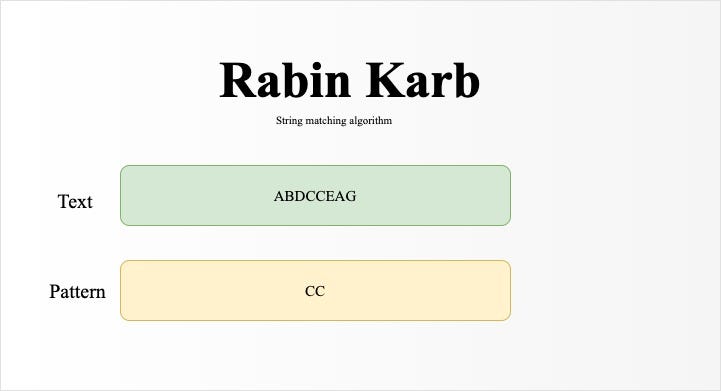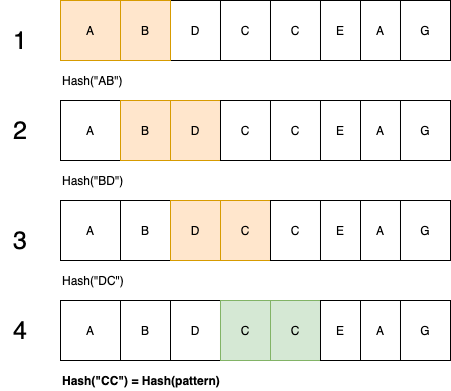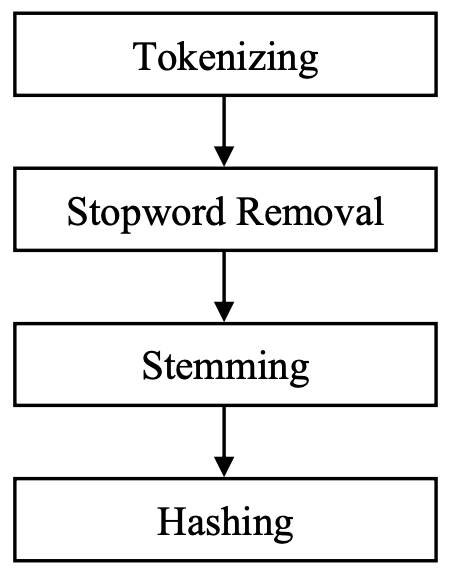A Simple Plagiarism Rate Checker Using Rabin-Karp String Matching Algorithm in Python and Golang
December 19, 2020

Plagiarism checker is the process of locating instances of plagiarism in a document. According to Oxford Dictionary of English, plagiarism is “the practice of taking someone else’s work or ideas and passing them off as one’s own” without proper citations. The widespread use of computers and the advent of the Internet have made it easier to plagiarize the work of others and get away with it, but with the help of a computer-aided plagiarism detector, we can determine the plagiarism level of two documents using the Rabin Karp algorithm.
What is Rabin Karp?
Rabin Karp algorithm is a string matching algorithm and this algorithm makes use of hash functions and the rolling hash technique. A hash function is essentially a function that map data of arbitrary size to a value of fixed size while A rolling hash allows an algorithm to calculate a hash value without having to rehash the entire string, this allows a new hash to be computed very quickly. We need to take note of two sets of data which are pattern and text, the pattern represents the string we are trying to match in the text.
The Rabin-Karp algorithm is an improved version of the brute force approach which compares each character of pattern with each character of text and has a time complexity of O(mn).
Major features
- uses a hashing function techniques and rolling hash;
- preprocessing phase in O(m) time complexity and constant space;
- searching phase in O(nm) time complexity;
- O(n+m) expected running time.
How it works
Given a pattern “cc” and a text “abdcceag”, I will demonstrate how the Rabin Karp algorithm works

As we iterate through the text we will generate the hash value for the current window which is of length pattern and compare it with the hash value of the pattern, if they don’t match, we move to the next window to generate the next hash value using the rolling hash technique. NB: subsequent hashes are computed from the previous hash, E.G “BD” is computed from “AB” E.T.C.
and finally, we found a match in the 4th window. So how can this simple technique be used in plagiarism detection in documents? well, I found two interesting research papers that did justice to that and this article further explains that with code implementations.
- Research paper 1: https://osf.io/8ju3h/download/
- Research paper 2: https://osf.io/yxjnp/download
Hash Functions
The hash function is a function that determines the feature value of a particular syllable fraction or word in the document. It converts each string into a number, called a hash value. Rabin-Karp algorithm determines hash value based on the same word K-Gram.
K-grams are k-length subsequences of a string, it can be 1,2,3,4 E.T.C. These are mostly used for spelling correction, but in this case, we are using k-gram to determine plagiarism pattern between two documents. K-gram is going to replace our pattern length in figure 1. A good hash function is important in order to prevent multiple words from having the same hash value which is popularly known as spurious hit and a bad hashing will invalidate our solution in the long run.
We will be using a modular arithmetic hash function with a technique called rolling hash where the input is hashed in a window that moves or iterate through the input in this article.
Modular arithmetic hash function:
We compute our string using a modular arithmetic hash function using the formula below
Rolling Hash
As discussed earlier, the rolling hash allows us to compute a new hash rapidly using the previous hash. We will compute our new hash using the formula below:

Example:
Given the text "abdcceag", let’s find the hash of window "ab" and bd using the modular arithmetic hash function and rolling hash technique.
Solution
We understand how Rabin Karp works, now it’s time to move on to the actual implementation, this process is going to involve four(4) different steps which include:

Text Processing Steps
- Tokenizing Tokenizing involves splitting text into individual words or terms, called tokens. It's like breaking down a sentence or paragraph into its component words.
- Stopword Removal This step involves removing common words that appear frequently in text but offer little value for analysis. Words like "because," "with," "and," "or," "not," and others are typically filtered out.
- Stemming Stemming reduces words to their base or root form. For instance, the words "car," "cars," "car's," "cars'" all stem from the root word "car". This process helps in standardizing words to their base form.
Code Implementation
Python
The prepare_content() handles stemming, tokenizing, and stopword removal, using natural language tool kit library (nltk)
# process_content.py
import nltk
from nltk.corpus import stopwords
from nltk.tokenize import word_tokenize
from nltk.stem import PorterStemmer
from nltk.stem import LancasterStemmer
class PlagiarismChecker:
def prepare_content(self, content):
# STOP WORDS
stop_words = set(stopwords.words('english'))
# TOKENIZE
word_tokens = word_tokenize(content)
filtered_content = []
# STEMMING
porter = PorterStemmer()
for w in word_tokens:
if w not in stop_words:
w = w.lower()
word = porter.stem(w)
filtered_content.append(word)
return filtered_contentGolang
Golang is a new programming language that has less support for natural language processing but I found some interesting libraries that implements stemming and tokenization pretty well. Check the code below but please endeavor to check the github repo for better context
// process_content.go
package main
import (
prose "github.com/jdkato/prose/v2
"
porterstemmer "github.com/reiver/go-porterstemmer"
)
type PlagiarismChecker struct {
HashTable map[string][]int
KGram int
}
// PrepareContent, prepares content by removing stopwords, steemming and tokenizing
func (pc PlagiarismChecker) PrepareContent(content string) string {
// TOKENIZE
doc, err := prose.NewDocument(content)
if err != nil {
log.Fatal(err)
}
data := []string{}
// Iterate over the doc's tokens:
for _, tok := range doc.Tokens() {
// STOP WORD REMOVAL
if !Contains(stopwords, tok.Text) {
// STEMMING
stem := porterstemmer.StemString(tok.Text)
data = append(data, stem)
}
}
return strings.Join(data[:], "")
}Step 4: Hashing
This step generates the hash value for the content in our document using the Rabin Karp algorithm with a specified K-gram value that determines the length of the string we need for each window after it has undergone the 3 steps listed above.
Implementation of Rabin Karp algorithm
Using the rolling hash technique and modular hash function
Python
class rolling_hash:
def __init__(self, text, patternSize):
self.text = text
self.patternSize = patternSize
self.base = 26
self.window_start = 0
self.window_end = 0
self.mod = 5807
self.hash = self.get_hash(text, patternSize)
def get_hash(self, text, patternSize):
hash_value = 0
for i in range(0, patternSize):
hash_value += (ord(self.text[i]) - 96)*(self.base**(patternSize - i -1)) % self.mod
self.window_start = 0
self.window_end = patternSize
return hash_value
def next_window(self):
if self.window_end <= len(self.text) - 1:
self.hash -= (ord(self.text[self.window_start]) - 96)*self.base**(self.patternSize-1)
self.hash *= self.base
self.hash += ord(self.text[self.window_end])- 96
self.hash %= self.mod
self.window_start += 1
self.window_end += 1
return True
return False
def current_window_text(self):
return self.text[self.window_start:self.window_end]
def checker(text, pattern):
if text == "" or pattern == "":
return None
if len(pattern) > len(pattern):
return None
text_rolling = rolling_hash(text, len(pattern))
pattern_rolling = rolling_hash(pattern, len(pattern))
for _ in range(len(text) - len(pattern) - 1):
if text_rolling.hash == pattern_rolling.hash:
return "Found"
text_rolling.next_window()
return "Not Found"
if __name__ == "__main__":
print(checker("abcdefgh", "a"))
Golang
package main
import (
"fmt"
"math"
"strings"
)
type RabinKarp struct {
Base int
Text string
PatternSize int
Start int
End int
Mod int
Hash int
}
func NewRabinKarp(text string, patternSize int) *RabinKarp {
rb := &RabinKarp{
Base: 26,
PatternSize: patternSize,
Start: 0,
End: 0,
Mod: 5807,
Text: text,
}
rb.GetHash()
return rb
}
//GetHash creates hash for the first window
func (rb *RabinKarp) GetHash() {
hashValue := 0
for n := 0; n < rb.PatternSize; n++ {
runeText := []rune(rb.Text)
value := int(runeText[n])
mathpower := int(math.Pow(float64(rb.Base), float64(rb.PatternSize-n-1)))
hashValue = Mod((hashValue + (value-96)*(mathpower)), rb.Mod)
}
rb.Start = 0
rb.End = rb.PatternSize
rb.Hash = hashValue
}
// NextWindow returns boolean and create new hash for the next window
// using rolling hash technique
func (rb *RabinKarp) NextWindow() bool {
if rb.End <= len(rb.Text)-1 {
mathpower := int(math.Pow(float64(rb.Base), float64(rb.PatternSize-1)))
rb.Hash -= (int([]rune(rb.Text)[rb.Start]) - 96) * mathpower
rb.Hash *= rb.Base
rb.Hash += int([]rune(rb.Text)[rb.End] - 96)
rb.Hash = Mod(rb.Hash, rb.Mod)
rb.Start++
rb.End++
return true
}
return false
}
// CurrentWindowText return the current window text
func (rb *RabinKarp) CurrentWindowText() string {
return rb.Text[rb.Start:rb.End]
}
func Checker(text, pattern string) string {
textRolling := NewRabinKarp(strings.ToLower(text), len(pattern))
patternRolling := NewRabinKarp(strings.ToLower(pattern), len(pattern))
for i := 0; i <= len(text)-len(pattern)+1; i++ {
fmt.Println(textRolling.Hash, patternRolling.Hash)
if textRolling.Hash == patternRolling.Hash {
return "Found"
}
textRolling.NextWindow()
}
return "Not Found"
}
func main() {
text := "ABDCCEAGmsslslsosspps"
pattern := "agkalallaa"
fmt.Println(Checker(text, pattern))
}Calculate document hash
Python
The below code makes use of the above-implemented Rabin Karp algorithm to calculate and generate the hash for our document content. Take note of calculate_hash() function and k_gram value, in this case, we are using 5 as our k-gram
import nltk
from nltk.corpus import stopwords
from nltk.tokenize import word_tokenize
from nltk.stem import PorterStemmer
from nltk.stem import LancasterStemmer
import rabin_karp
import numpy as np
from os.path import dirname, join
class PlagiarismChecker:
def __init__(self, file_a, file_b):
self.valid = False
self.file_a = file_a
self.file_b = file_b
self.hash_table = {"a": [], "b": []}
self.k_gram = 5
content_a = self.get_file_content(self.file_a)
content_b = self.get_file_content(self.file_b)
self.calculate_hash(content_a, "a")
self.calculate_hash(content_b, "b")
# calaculate hash value of the file content
# and add it to the document type hash table
def calculate_hash(self, content, doc_type):
text = self.prepare_content(content)
text = "".join(text)
text = rabin_karp.rolling_hash(text, self.k_gram)
for _ in range(len(content) - self.k_gram + 1):
self.hash_table[doc_type].append(text.hash)
if text.next_window() == False:
break
# get content from file
def get_file_content(self, filename):
file = open(filename, 'r+', encoding="utf-8")
return file.read()
# Prepare content by stemming, tokenizing and removing stopwords.
def prepare_content(self, content):
# STOP WORDS
stop_words = set(stopwords.words('english'))
# TOKENIZE
word_tokens = word_tokenize(content)
filtered_content = []
# STEMMING
porter = PorterStemmer()
for w in word_tokens:
if w not in stop_words:
w = w.lower()
word = porter.stem(w)
filtered_content.append(word)
return filtered_content
Golang
Take note of the CalculateHash() function and KGram value
package main
import (
"fmt"
"io/ioutil"
"log"
"path"
"path/filepath"
"strings"
prose "github.com/jdkato/prose/v2"
porterstemmer "github.com/reiver/go-porterstemmer"
)
type PlagiarismChecker struct {
HashTable map[string][]int
KGram int
}
var (
_, currentPath, _, _ = runtime.Caller(0)
)
func NewPlagiarismChecker(fileA, fileB string) *PlagiarismChecker {
checker := &PlagiarismChecker{
KGram: 5,
HashTable: make(map[string][]int),
}
checker.CalculateHash(checker.GetFileContent(fileA), "a")
checker.CalculateHash(checker.GetFileContent(fileB), "b")
return checker
}
// PrepareContent, prepares content by removing stopwords, steemming and tokenizing
func (pc PlagiarismChecker) PrepareContent(content string) string {
// TOKENIZE
doc, err := prose.NewDocument(content)
if err != nil {
log.Fatal(err)
}
data := []string{}
// Iterate over the doc's tokens:
for _, tok := range doc.Tokens() {
// STOP WORD REMOVAL
if !Contains(stopwords, tok.Text) {
// STEMMING
stem := porterstemmer.StemString(tok.Text)
data = append(data, stem)
}
}
return strings.Join(data[:], "")
}
// CalculateHash calaculates the hash value of the file content
// and add it to the document type hash table
func (pc PlagiarismChecker) CalculateHash(content, docType string) {
text := pc.PrepareContent(content)
fmt.Println(text)
textRolling := NewRabinKarp(strings.ToLower(text), pc.KGram)
for i := 0; i <= len(text)-pc.KGram+1; i++ {
if len(pc.HashTable[docType]) == 0 {
pc.HashTable[docType] = []int{textRolling.Hash}
} else {
pc.HashTable[docType] = append(pc.HashTable[docType], textRolling.Hash)
}
if textRolling.NextWindow() == false {
break
}
}
fmt.Println(pc.HashTable)
}
// GetFileContent get content from file
func (pc PlagiarismChecker) GetFileContent(filename string) string {
data, err := ioutil.ReadFile(filename)
if err != nil {
panic(err)
}
return string(data)
}Rate Calculation
We compute Plagiarism Rate using the formula below

Where:
- P is the Plagiarism Rate
- SH is the Identical Hash
- THA is the Total Hash in Document A
- THB is the Total Hash in Document B
Final Code (Python)
Take note of the calculate_plagiarism_rate() function, we computed this function using the formula given above and we calculated our identical hash using numpy intersect1d() function
import nltk
from nltk.corpus import stopwords
from nltk.tokenize import word_tokenize
from nltk.stem import PorterStemmer
from nltk.stem import LancasterStemmer
import rabin_karp
import numpy as np
from os.path import dirname, join
class PlagiarismChecker:
def __init__(self, file_a, file_b):
self.file_a = file_a
self.file_b = file_b
self.hash_table = {"a": [], "b": []}
self.k_gram = 5
content_a = self.get_file_content(self.file_a)
content_b = self.get_file_content(self.file_b)
self.calculate_hash(content_a, "a")
self.calculate_hash(content_b, "b")
# calaculate hash value of the file content
# and add it to the document type hash table
def calculate_hash(self, content, doc_type):
text = self.prepare_content(content)
text = "".join(text)
text = rabin_karp.rolling_hash(text, self.k_gram)
for _ in range(len(content) - self.k_gram + 1):
self.hash_table[doc_type].append(text.hash)
if text.next_window() == False:
break
def get_rate(self):
return self.calaculate_plagiarism_rate(self.hash_table)
# calculate the plagiarism rate using the plagiarism rate formula
def calaculate_plagiarism_rate(self, hash_table):
th_a = len(hash_table["a"])
th_b = len(hash_table["b"])
a = hash_table["a"]
b = hash_table["b"]
sh = len(np.intersect1d(a, b))
print(sh, a, b)
# Formular for plagiarism rate
# P = (2 * SH / THA * THB ) 100%
p = (float(2 * sh)/(th_a + th_b)) * 100
return p
# get content from file
def get_file_content(self, filename):
file = open(filename, 'r+', encoding="utf-8")
return file.read()
# Prepare content by removing stopwords, steemming and tokenizing
def prepare_content(self, content):
# STOP WORDS
stop_words = set(stopwords.words('english'))
# TOKENIZE
word_tokens = word_tokenize(content)
filtered_content = []
# STEMMING
porter = PorterStemmer()
for w in word_tokens:
if w not in stop_words:
w = w.lower()
word = porter.stem(w)
filtered_content.append(word)
return filtered_content
current_dir = dirname(__file__)
checker = PlagiarismChecker(
join(current_dir, "./document_a.txt"),
join(current_dir, "./document_b.txt")
)
print('The percentage of plagiarism held by both documents is {0}%'.format(
checker.get_rate()))Final code (Golang)
Take note of the CalculatePlagiarismRate() function.
package main
import (
"fmt"
"io/ioutil"
"log"
"path"
"path/filepath"
"reflect"
"runtime"
"strings"
prose "github.com/jdkato/prose/v2"
porterstemmer "github.com/reiver/go-porterstemmer"
)
type PlagiarismChecker struct {
HashTable map[string][]int
KGram int
}
var (
_, currentPath, _, _ = runtime.Caller(0)
)
func NewPlagiarismChecker(fileA, fileB string) *PlagiarismChecker {
checker := &PlagiarismChecker{
KGram: 5,
HashTable: make(map[string][]int),
}
checker.CalculateHash(checker.GetFileContent(fileA), "a")
checker.CalculateHash(checker.GetFileContent(fileB), "b")
return checker
}
// PrepareContent, prepares content by removing stopwords, steemming and tokenizing
func (pc PlagiarismChecker) PrepareContent(content string) string {
// TOKENIZE
doc, err := prose.NewDocument(content)
if err != nil {
log.Fatal(err)
}
data := []string{}
// Iterate over the doc's tokens:
for _, tok := range doc.Tokens() {
// STOP WORD REMOVAL
if !Contains(stopwords, tok.Text) {
// STEMMING
stem := porterstemmer.StemString(tok.Text)
data = append(data, stem)
}
}
return strings.Join(data[:], "")
}
// CalculateHash calaculates the hash value of the file content
// and add it to the document type hash table
func (pc PlagiarismChecker) CalculateHash(content, docType string) {
text := pc.PrepareContent(content)
fmt.Println(text)
textRolling := NewRabinKarp(strings.ToLower(text), pc.KGram)
for i := 0; i <= len(text)-pc.KGram+1; i++ {
if len(pc.HashTable[docType]) == 0 {
pc.HashTable[docType] = []int{textRolling.Hash}
} else {
pc.HashTable[docType] = append(pc.HashTable[docType], textRolling.Hash)
}
if textRolling.NextWindow() == false {
break
}
}
fmt.Println(pc.HashTable)
}
func (pc PlagiarismChecker) GetRate() float64 {
return pc.CalculatePlagiarismRate()
}
// GetFileContent get content from file
func (pc PlagiarismChecker) GetFileContent(filename string) string {
data, err := ioutil.ReadFile(filename)
if err != nil {
panic(err)
}
return string(data)
}
// CalculatePlagiarismRate calculates the plagiarism rate using the plagiarism rate formula
func (pc PlagiarismChecker) CalculatePlagiarismRate() float64 {
THA := len(pc.HashTable["a"])
THB := len(pc.HashTable["b"])
intersect := Intersect(pc.HashTable["a"], pc.HashTable["b"])
SH := reflect.ValueOf(intersect).Len()
// Formular for plagiarism rate
// P = (2 * SH / THA + THB ) 100%
fmt.Println(SH, THA, THB)
p := float64(2*SH) / float64(THA+THB)
return float64(p * 100)
}
func main() {
//get root
Root := filepath.Join(filepath.Dir(currentPath), "../")
docsPath := path.Join(Root, "/docs/")
checker := NewPlagiarismChecker(
path.Join(docsPath, "/document_a.txt"),
path.Join(docsPath, "/document_b.txt"),
)
fmt.Printf("The percentage of plagiarism held by both documents is %f", checker.GetRate())
}NB: “The length of K-Gram is the determinant of the plagiarism level. Determining the proper length of K-Gram, improves our plagiarism level results. The results will vary foreach K-Gram value.”
Demo
Given document A
The process of searching for a job can be very stressful, but it doesn’t have to be. Start with a well-written resume that has appropriate keywords for your occupation. Next, conduct a targeted job search for positions that meet your needs.
…and document B
Looking for a job can be very stressful, but it doesn’t have to be. Begin by writing a good resume with appropriate keywords for your occupation. Second, target your job search for positions that match your needs.
….after the computation of both documents in python, The percentage of plagiarism held by both documents is **50.76142131979695%
while** in golang i got 53.731343%.

Time Complexity
The Rabin-Karp algorithm has the complexity of O(nm) for the worst case, O(n + m) for the best case where n is the length of the text, while m is the length of the pattern. So where is it compared to brute-force matching? Well, brute force matching complexity is O(nm), so as it seems there’s not much of a gain in performance. However, it’s considered that Rabin-Karp’s complexity is O(n+m) in practice with an efficient hash function and that makes it a bit faster.
Conclusion
Detecting the rate of plagiarism in a document is dependent on the value of k-gram and the calculation of hash value greatly affects the result of this algorithm. Higher K-Gram values tend to have a low level of similarity, while lower K-Gram values increase the percentage of similarity, and also, a good hash function is crucial in order to prevent spurious hit. To be honest, the modular hash function is not the best, check out this article for other interesting techniques to improve our hash function. This solution is not the best but I believe we have been able to demonstrate an interesting solution on how this can work in real-life applications
References
There is so much to learn about string matching that we didn't cover in this article. The resources below made this article possible.
- Content similarity detection, Wikipedia
- Spelling correction using K-grams, Geeks for Geeks
- Rabin Karp algorithm, Brilliant.org
- Rolling Hash, Wikipedia
GitHub Repository
Endeavor to check out the full code 🤜 https://github.com/TheDhejavu/plagiarism-checker/